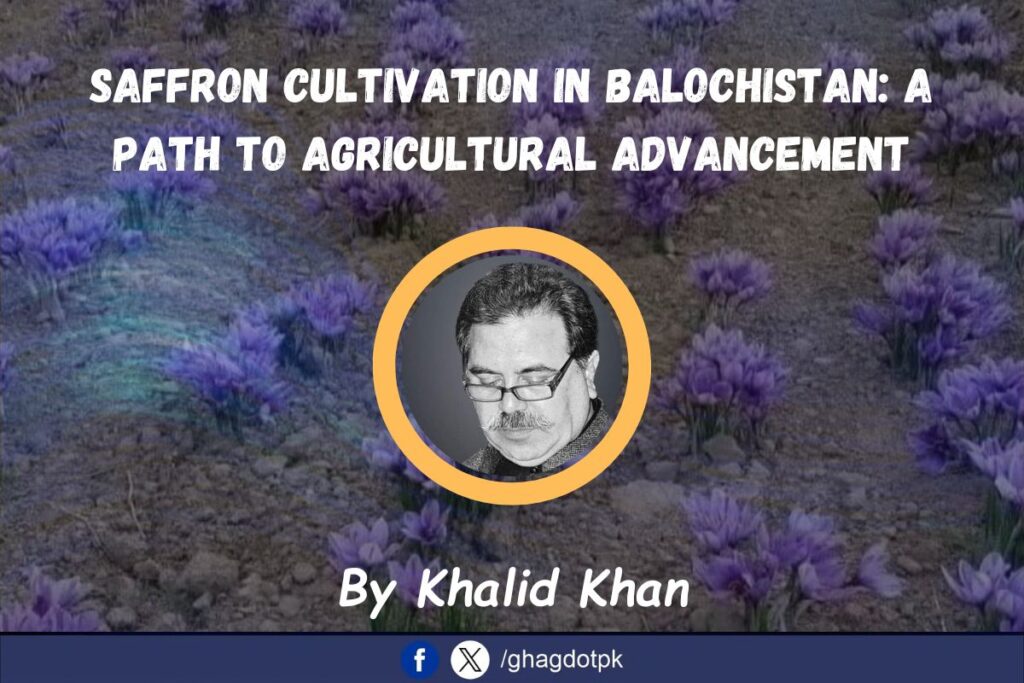By Khalid Khan
The recent success of saffron cultivation in Balochistan has opened up new possibilities for agricultural growth in the region. Saffron, known as the world’s most expensive spice, is not only proving to be a lucrative crop for Pakistan but is also offering better income prospects for Balochistan’s farmers. This development could play a vital role in the overall modernization and diversification of the province’s agricultural sector.
Balochistan, with its distinct climatic conditions, offers an ideal environment for saffron cultivation. The province’s cooler regions, where temperatures drop below 30°C, provide the perfect setting for saffron, a crop that thrives in cold weather. The method of saffron cultivation is similar to that of garlic, with planting typically beginning in August or September, and the crop being ready for harvest by March or April. Notably, saffron requires minimal water, with irrigation provided at 12-day intervals, significantly reducing the labor involved for farmers.
One of the major advantages of saffron cultivation is its propagation method, which involves planting bulbs instead of seeds. These bulbs are divided into five or six sections and buried in separate areas of land. This approach is not only efficient but also reduces the dependency on seeds, making saffron a sustainable crop.
The financial benefits of saffron are substantial. A gram of saffron can sell for around 750 Pakistani rupees, and the price can reach up to 750,000 rupees per kilogram. With such high returns, saffron offers an attractive alternative for Balochistan’s farmers, especially when compared to traditional crops.
Saffron’s successful cultivation in Balochistan signals a step forward in transforming the agricultural landscape of the region. Historically, the province’s agriculture has been dependent on traditional crops such as wheat, barley, and cotton, which have struggled with fluctuating market prices and limited profitability. By diversifying into high-value crops like saffron, olive, and other profitable alternatives, Balochistan’s farmers can not only improve their livelihoods but also contribute to the region’s economic growth.
Agricultural experts emphasize the need for a shift towards modern, high-value crops to revitalize Balochistan’s agricultural sector. The introduction of saffron is a promising step in this direction, as it not only promises higher returns but also showcases the potential for further innovation in the province’s agricultural practices.
In light of these developments, Balochistan’s landowners are encouraged to explore new farming avenues beyond traditional crops. Investing in crops like saffron, olive, and other cash crops could enhance the province’s agricultural output, improve the economic conditions of local farmers, and offer sustainable alternatives to age-old agricultural practices.
A Booming Agricultural Sector in Balochistan
Balochistan’s agricultural sector has long faced challenges, including water scarcity, outdated farming practices, and lack of access to modern technology. However, with the successful introduction of crops like saffron, there is hope for a brighter future. The province has the potential to become a leading producer of high-value crops, with the right investments in technology, irrigation systems, and farmer education.
Currently, Balochistan’s agricultural output includes crops like wheat, barley, and cotton, but the success of niche crops such as saffron and olive can significantly boost the province’s agricultural profile. The government’s role in promoting such crops, providing training to farmers, and facilitating access to international markets will be crucial in unlocking Balochistan’s full agricultural potential.
With proper attention to infrastructure, market access, and farmer incentives, Balochistan can evolve into a hub for high-value agricultural products, contributing not just to the region’s economy but also to the broader national economy. The success of saffron cultivation is just the beginning of this transformation.
Saffron: A Global Perspective
Saffron (Crocus sativus) is a perennial plant, famous for its rich color and flavor, often used in culinary dishes, perfumes, and traditional medicines. Cultivating saffron is labor-intensive and requires specific climatic conditions, including a cold and dry environment. The majority of the world’s saffron is produced in Iran, followed by countries like India, Spain, and Afghanistan. However, Balochistan’s successful experimentation with saffron has positioned it as a competitive player in the global saffron market.
As demand for saffron continues to rise due to its culinary and medicinal properties, Balochistan’s farmers stand to benefit from tapping into this lucrative global market. With continued investment and focus on quality production, saffron could become a flagship crop for Balochistan, further elevating the region’s agricultural stature on the world stage.
In conclusion, Balochistan’s journey into saffron cultivation highlights a promising future for the region’s agricultural sector. By embracing innovative farming practices and diversifying into high-value crops, Balochistan can lay the foundation for a more prosperous and sustainable agricultural economy. The key lies in empowering local farmers, modernizing agricultural techniques, and ensuring access to global markets.
Khalid Khan is a senior Pashtun journalist, author, and analyst, known for his unwavering advocacy for peace. He is currently the Editor of the English section at Ghag (ghag.pk) and brings years of experience and a deep understanding of the complexities facing Khyber Pakhtunkhwa, Balochistan, and Afghanistan. Khalid works on human interest topics, political economy, and sustainable agriculture, with a focus on promoting organic farming and developing local crops that are best suited to the soil.






